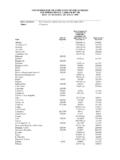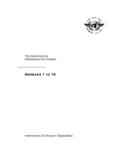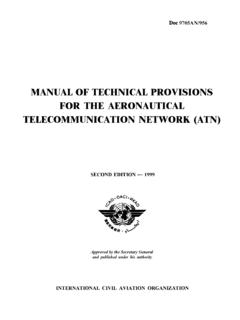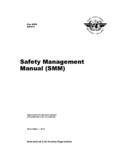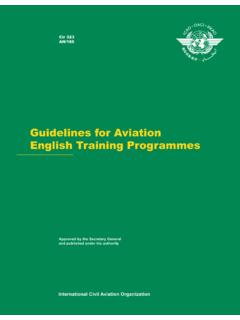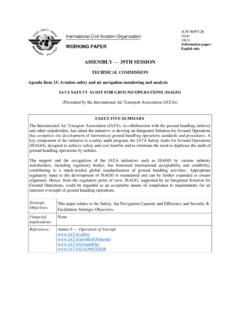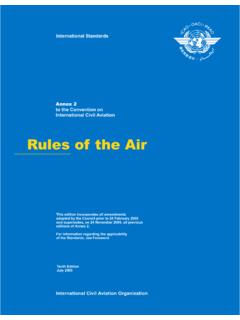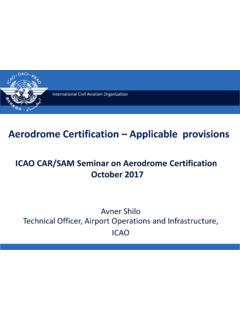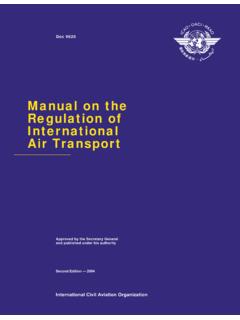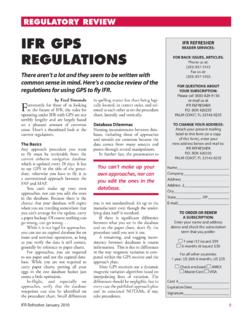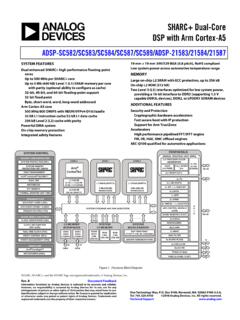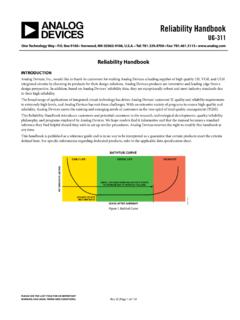Transcription of RNP AR APCH - ICAO
1 RNP AR APCH 07-10 April 2015 Background on ICAO Guidance for RNP AR APCH Procedures Developed based on operational experience in implementing unique approach procedures in multiple States United States (Alaska Airlines), Canada (West Jet), New Zealand, Australia (Qantas) Developed to take advantage of navigation capabilities in existing RNP-certified aircraft AR = Authorization Required Similar to how CAT III Instrument Landing System (ILS) is approved by Civil Aviation Authorities (CAA) RNP AR APCH capabilities are available in a limited number of current aircraft and for which current operators have limited experience Specific authorization ensures adequate CAA oversight of aircraft and operator to safely conduct these procedures 2 3 Capabilities Reduced Lateral & Vertical Obstacle Clearance Takes advantage of improved aircraft performance Curved Paths Use Radius-to-Fix (RF)
2 Legs where & when appropriate RNP AR Missed Approach Guidance Enable lower minima where extraction requires precise guidance 4 Applications (1) RNP AR APCH can be used to increase safety and access where conventional approach cannot be aligned to runway US Honolulu procedure provides stabilized approach with final segment aligned to runway 5 Applications (2) RNP AR APCH can be used to improve safety and increase access in mountainous terrain US: Palm Springs procedure provides approach through mountainous terrain 6 Applications (3) RNP AR APCH can be used to increase access in congested airspace US Chicago Midway (MDW) procedure provides approach without conflicting with Chicago O Hare (ORD) traffic Successful RNP Implementation Requires All The Elements Be Put In Place 7 = safe and efficient RNP AR operations Airport & Facility Capability Regulatory Capability + + Airline Capability + Airplane Capability Air Traffic Capability + Key Elements of Operational Approval.
3 RNP AR APCH 8 Equipment/System Standards Operational Procedures and Standards Operational Approval Procedure Design Criteria Types of Procedures RNP AR APCH provides several types of procedures to accommodate different aircraft capabilities Varying accuracy values (RNP , RNP ) Straight segments only or curved segments (RF) RNP APCH or RNP AR APCH missed approach These characteristics are indicated on each published approach 9 RNP (AR) Approach:RNP Segment Width 10 PLAN VIEW PROFILE VIEW Course Centerline 2 RNP 2 RNP 2 RNP 2 RNP 4 RNP 2xRNP 2xRNP ROC / MOC RNP (AR) Approach Radius to Fix (RF) Turns 11 2 RNP 2 RNP Cross Section ROC/MOC Aircraft Eligibility for RNP AR APCH Aircraft eligibility must be determined through demonstration of compliance against the relevant aircraft qualification criteria Typically documented by Aircraft Manufacturer and accepted by CAA May not require new Aircraft Flight Manual (AFM)
4 Entries if previous systems and equipment are adequate Aircraft equipment eligibility includes: Aircraft qualification Maintenance procedures Minimum Equipment List (MEL) revisions 12 RNP AR APCH System Performance Monitoring and Alerting Different from other Navigation Specifications Unique vertical accuracy requirements Unique monitoring and alerting due to reduced obstacle clearance Lateral Accuracy: Range of accuracy values ( to NM) Vertical Accuracy: Defines of system error in vertical direction 13 Monitoring and Alerting - Example 14 RNP AR APCH System Monitoring and Alerting Alerting relates to.
5 Lateral and vertical performance Vertical addressed through several operational mitigations fault -free and faulted performance consistent with safety objective Aircraft and operational requirements work together to meet the requirements for the approach GNSS and Baro-VNAV equipped aircraft can comply when the aircraft operation is in harmony with the guidance May require new pilot training and procedures Alternate means of compliance for the aircraft can help the operator achieve operational approval Probability of exceeding the lateral and vertical obstacle clearance volume must be less than 1 10-7 per approach 15 RNP AR APCH Specific Navigation Service Requirements Global Navigation Satellite System (GNSS) Required to begin any RNP AR APCH Inertial Reference Unit (IRU) Required for any RNP AR APCH with accuracy value less than NM or missed approach with RNP less than NM Distance Measuring Equipment (DME)
6 DME/DME updating may serve as reversionary mode where infrastructure and aircraft can provide required missed approach performance VHF Omni-Directional Range (VOR) Stations The RNAV system may not use VOR updating 16 Key Altimetry Functions for RNP AR APCH Altimetry performance is a key component of RNP AR APCH Criteria requires two, independent altimetry sources in the pilots primary field of view Requires a flight crew altimeter crosscheck within 100 Confirms satisfactory input to FMC providing the vertical path Requirement may be met by automated comparator monitor function Absence of automated function requires procedural mitigation flight crew procedures When the flight crew sets the altimeter, this must also set the RNP system s (FMC) altimeter input through a single action 17 Key Aircraft Functions.
7 Display 18 Displays that support flight crew monitoring of lateral and vertical deviation Operational procedure: Numeric display Requirements for RNP AR APCH with RF Legs For approaches where RF legs are used (indicated on chart): Navigation system must have the capability to execute RF legs between two fixes Aircraft must have an electronic map The FMC, flight director and Autopilot must be capable of commanding 25 of bank at or above 400 AGL and 8 of bank below 400 AGL 5 maneuverability margin over the 20 used in procedure 19 Example.
8 Radius to Fix (RF) Turns 20 Max Airspeed + Tailwind Bank angle to hold turn (Max) Maneuverability Margin Turn Radius (Min) Automatic Flight Control Command Authority Key Requirements for RNP AR APCH Less Than No single point of failure can cause loss of guidance required for the approach Aircraft typically require: dual GNSS sensors, dual FMS, dual air data systems, dual autopilots and a single IRS Loss of display of lateral guidance is hazardous System performance, monitoring and alerting of vertical errors consistent with safety objective Vertical obstacle clearance reduced with increased lateral accuracy System crosscheck can provide operational mitigation 21 Key Requirements for RNP AR Missed Approach Less than When possible.
9 Missed approach will use RNAV or conventional criteria Enables participation by more aircraft When missed approach requires accuracy value < NM (RNP AR missed approach): No single point of failure can cause loss of guidance dual equipage (same as RNP AR APCH < ) Loss of display of lateral guidance is hazardous Must be able to couple Autopilot/Flight Director by 400 AGL Upon loss of GNSS, aircraft must revert to another means of navigation complying with the navigation accuracy requirement 22 Example: Missed Approach with Inertial of growth (seconds)Growth in 95% Accuracy (NM)23 Loss of GNSS updating is considered ( , interference): Immediate effect is to revert to inertial navigation.
10 Key Requirements for RNP AR Flight guidance should remain in LNAV upon TOGA or other means of go-around/missed approach Navigation system may revert to track-hold or heading hold , and if followed, drive aircraft off procedure path 24 Example: Go-Around Alignment 25 Actual guided track Is average of prior track Criteria ensures straight alignment segment for procedures where precision guidance is required in missed approach (accuracy values less than NM) Decision Altitude Point Preflight Planning for RNP AR APCH Minimum Equipment List (MEL)
